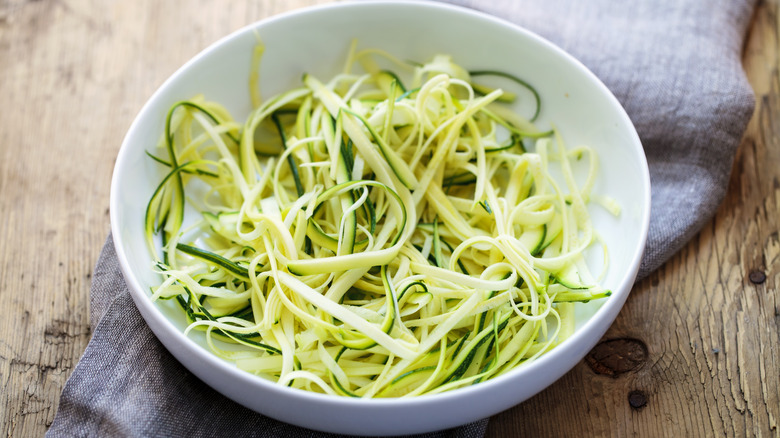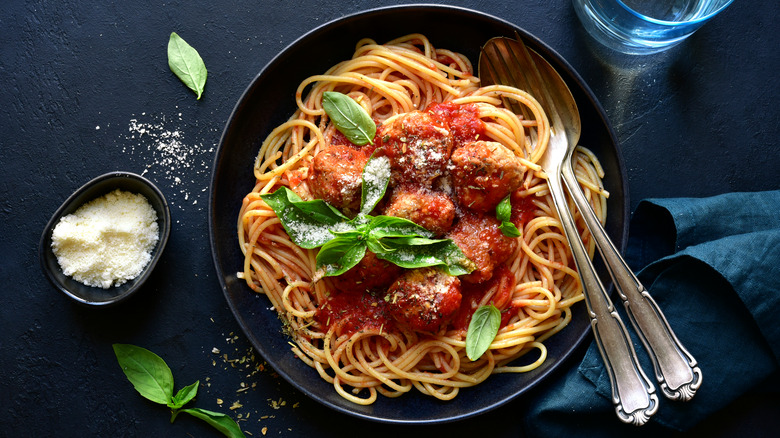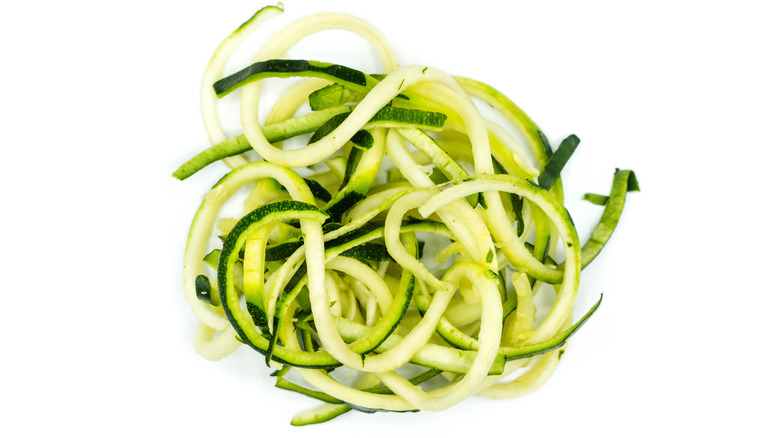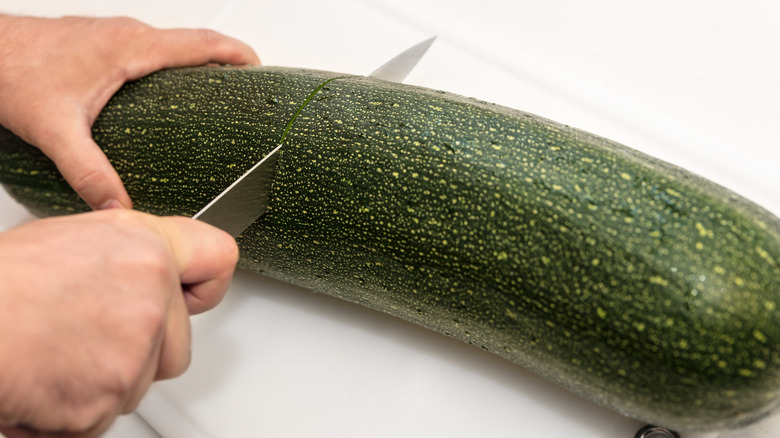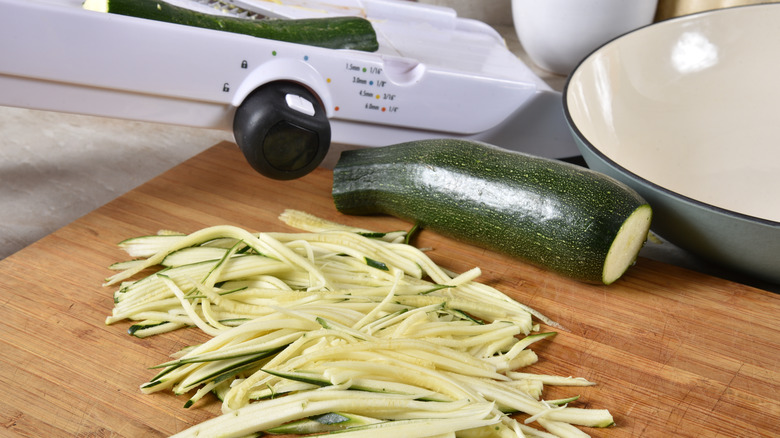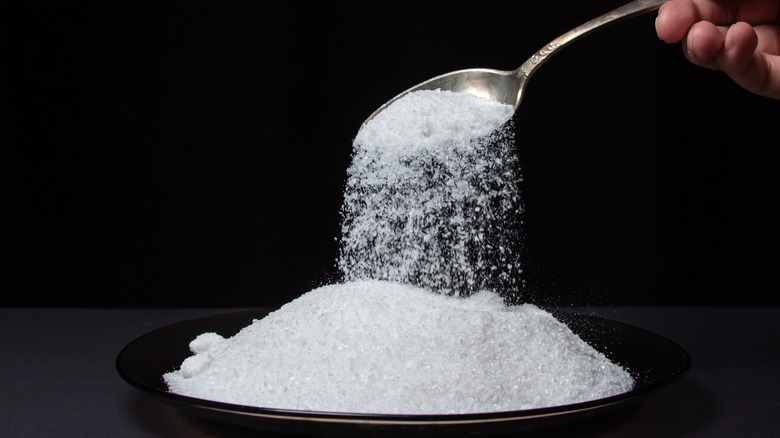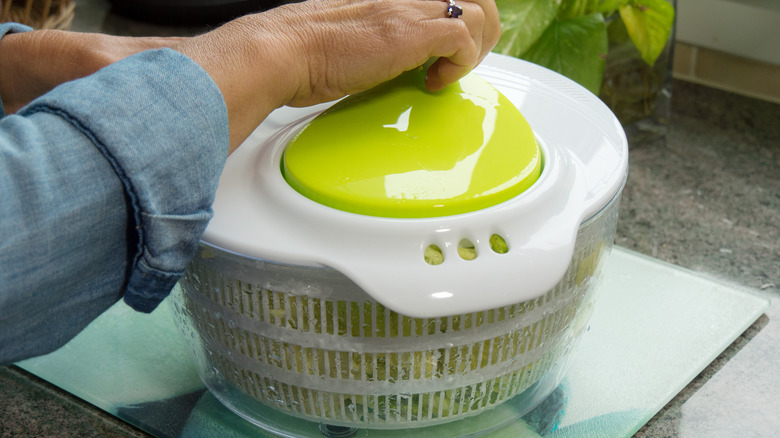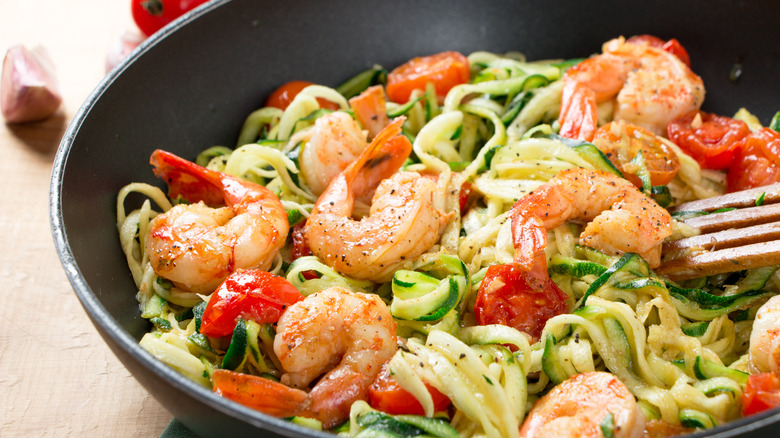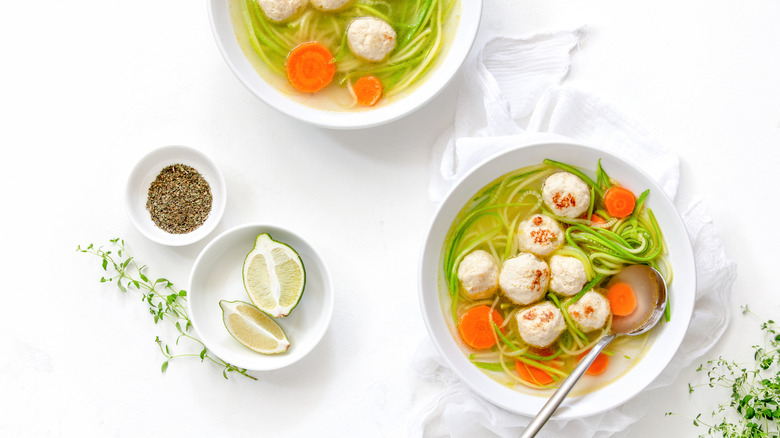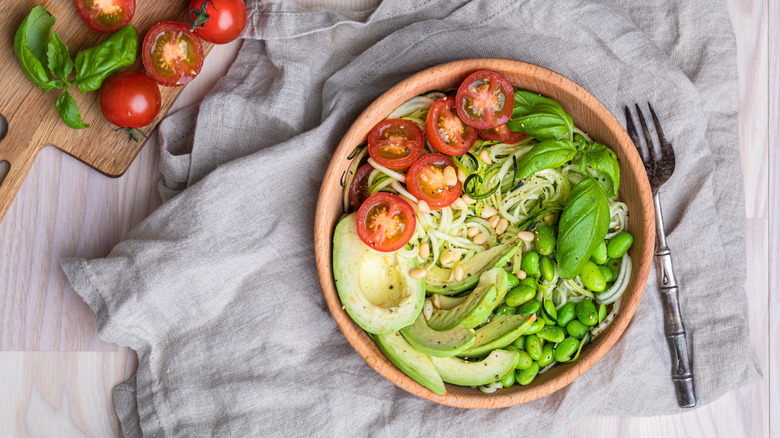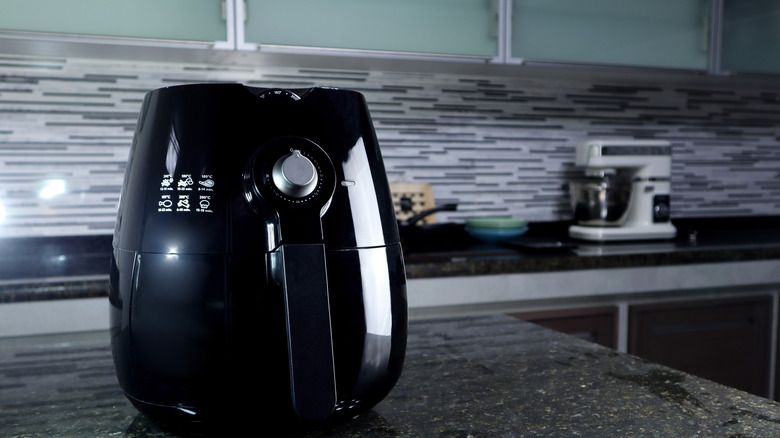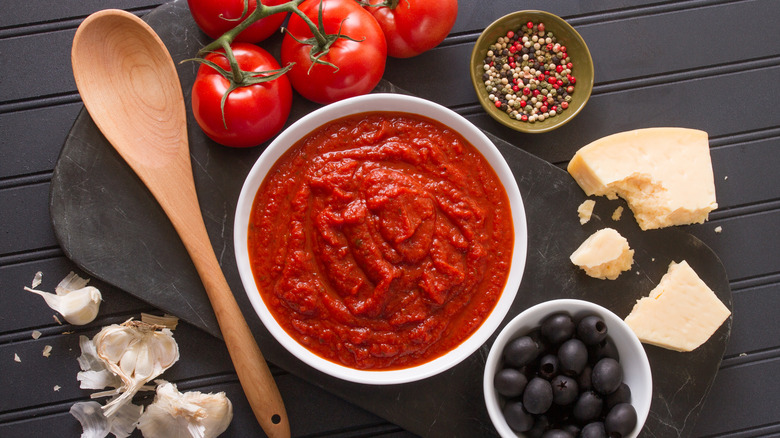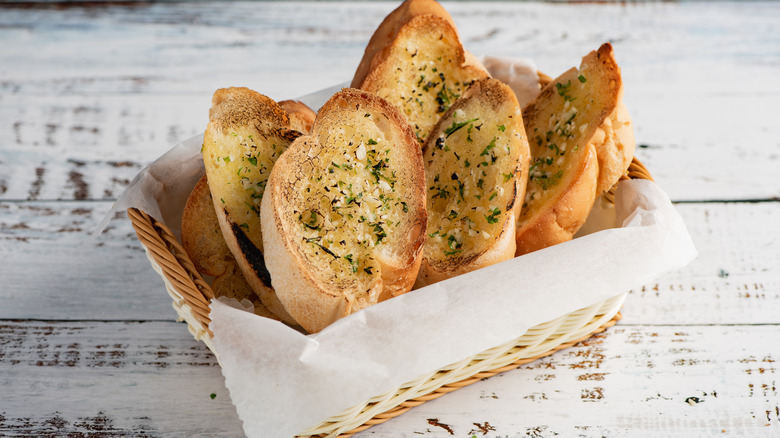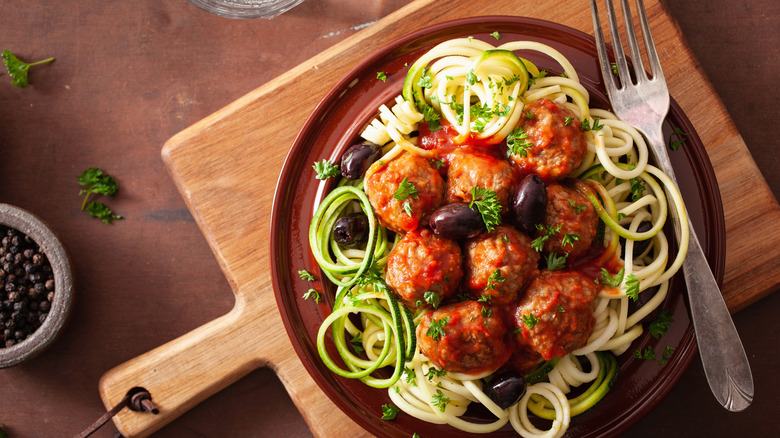Mistakes Everyone Makes When Making Zucchini Noodles
If you have a vegetable garden, you know that zucchini is easy to grow. Sometimes it seems like it is too easy, and you spend weeks making zucchini bread, frying zucchini sticks, or leaving baskets on your neighbors' doorsteps. Despite its reputation for being boring, zucchini has a lot going for it. It's low in calories, high in fiber, full of vitamins, and works in tons of recipes (via EatThisMuch).
You've likely heard of zucchini noodles or zoodles. These spiralized zucchini ribbons have been popular in the United States since the early '90s. Still, Europeans were eating the same thing and calling it courgetti (courgette means zucchini in French) decades earlier. Zoodles are a great way to up your veggie intake; no matter how nutrition guidelines have shifted over the past century, the importance of eating fruits and vegetables is consistently mentioned (via My Plate).
Zoodles have their detractors, of course. Some of the most common complaints have to do with texture or how soggy they are, like one Reddit user, OldManIcyHot, who points out that even thick sauces won't help because when you add zoodles, "it's just a watery mess." If you've never achieved perfect zoodles, here are some common mistakes to avoid.
You're thinking of them as pasta
Zucchini noodles tend to elicit strong opinions, but maybe our expectations are to blame. On the r/unpopularopinion Reddit thread, user S00perJeezus responded logically to accusations that zoodles are "straight trash," noting that if someone simply said "[they're] vegetables, prepared a different way, I'm good. But those are as much noodles as shoelaces are!" This is a good take; if you make zoodles and expect them to taste like pasta, you will likely be disappointed.
Our society has a complicated relationship with pasta. Many people think they shouldn't eat pasta between carbs, calories, and gluten. We don't think you need to go that far, but since traditional semolina pasta flour is refined, the germ and bran are stripped from the wheat kernel. Unfortunately, that removes a lot of nutrients and fiber while delivering 220 calories in just one cup (via Healthline). Spoiler alert: most of us eat more than one cup of pasta, so a spaghetti dinner's calorie count might shock you.
Instead, celebrate zoodles for what they are: a way to eat more vegetables while eating far fewer calories, and to feel energized instead of groggy after eating. A cup of zucchini only has 27 calories per cup while providing 1.8 grams of fiber and 2.1 grams of protein and vitamins our bodies need daily (via EatThisMuch). Zoodles work with any eating style and can be incorporated into any rice or pasta recipe.
Not getting rid of seeds
Considering texture is a major sticking point when it comes to zoodles, deciding to keep the seeds intact could be a mistake — just thinking about thin ribbons of zucchini with seeds jutting out every which way ruins the whole experience for us. Reddit users point out that the "seedy parts" lack structure and will make zoodles watery. Extra water content is not your friend if you want that al dente texture in your plate of zoodles.
Some spiralizers automatically core the zucchini for you, or you can make zoodles yourself using a knife or vegetable peeler (more on that later). If you don't want to waste food, you can use the zucchini's core another way: Chop it up, then add it to stir fry, a soup, a quiche, or fritters.
The easiest way to core a zucchini by hand is to trim the ends, cut it in half, and look at where the seeds are. You can stand the zucchini on its end and cut down each side, leaving long, flat slabs for zoodle-making or whatever recipe you have.
Using huge zucchini
Whether buying zucchini or growing them yourself, it's tempting to go for a giant squash to make zoodles. After all, a huge zucchini will make lots of zoodles, so you'll only need one for the whole meal, right? That would be a big no. Unfortunately, zucchini doesn't improve with size; instead, it becomes flavorless, woody, or even bitter with tougher skin. The seeds also grow along with the zucchini, making it harder to make proper zoodles.
Smaller zucchini are better for any recipe where you want to focus on its delicate flavor. Bonus: They also have tinier and fewer seeds, which is ideal for zucchini noodles. Since zoodles are cooked quickly or eaten raw, only the freshest, most tender zucchini will do. Focus on choosing slim squash no bigger than 8 inches long to get an outstanding flavor and delicious skin — your zoodle game will automatically level up.
If you're a gardener overrun with colossal zukes, don't despair. Since the flavor and texture won't be as lovely, use extended cooking methods like roasting or baking, or choose recipes where zucchini flavor isn't the star. For example, baking zucchini into chocolate muffins shifts the focus to the deep chocolate flavor of cocoa and chocolate chips. If you prefer a savory vegetarian dish, stuff them with Mediterranean flavors and roast them, transforming them into delectable Hasselback zucchini.
Thinking you need a spiralizer
Spiralizers are useful for more than zucchini noodles; you can use them for curly fries or make various vegetables pretty and appealing to kids. Still, if you don't have a ton of space in your kitchen or don't want another gadget, you can make zoodles without one.
According to Kelly Senyei of JustATaste, several handy tools you may already own can help you make zoodles as quickly as a spiralizer would. Working with a julienne peeler, you can produce long, thin strands, or use a mandoline to cut wide, flat zoodles for veggie lasagna. Mandolines usually include other blades, so if you have one, it might make several shapes.
If you want ribbony zoodles, your regular vegetable peeler is perfect, and if fancy knife work is your thing, go ahead and use a sharp knife to make the shape you have in mind. In other words, make zucchini noodles any way you want, and no worries if you don't own a particular gadget. Life's too short to worry about which spiralizer to buy.
Not using salt to your advantage
Let's face it: Plain zucchini is pretty bland. Zucchini has plenty of nutritional benefits, but that means nothing if you don't enjoy the meal. Zoodles work with any cuisine, so always experiment with herbs and spices, but never forget the salt. Yes, salt improves flavor, but when it comes to zoodles, it's critical for another reason.
Imagine zoodles like a wet pile of boiled spinach rather than al dente pasta. Now picture water leaching out of them, leaving puddles on the plate, and wrecking the perfect pasta sauce. Not terribly appetizing, right?
Don't worry; avoiding this problem just takes a bit of time and some salt. No matter which way you cut zucchini into zoodles, use paper towels (or a clean kitchen towel) to squeeze as much water from the zucchini as possible. Then put the zoodles on a tray lined with dry paper towels and sprinkle plenty of salt over the top. Let them sit for at least a half hour, then squeeze them again. You'll be amazed how much water comes out of the zoodles, and don't worry, most of the salt comes with it (via Kristen Boehmer). While you should taste the zoodles before adding more salt to the dish, you can rest easy knowing they won't be soggy.
Not letting them drain after spiralizing
While some cooks salt zoodles and drain them in a colander, there are other ways. If you prep ingredients for the week, it's easy to drain zucchini noodles in the fridge days ahead with no fuss. Store them in an airtight container on paper towels, which will absorb the moisture effortlessly (via Kristen Boehmer). Remember, it's a good idea to change the paper towels when they get too wet, but this lets you store them for several days and have fresh, crisp zoodles whenever you're ready to cook.
If your idea of meal planning is more haphazard, but the idea of the squeeze method seems like a hassle, a salad spinner might be just the ticket (via BuzzFeed). Salt the zoodles in the colander bowl of the spinner, let them sit a while, and spin away the extra liquid. The result? Fresh, crisp zoodles, even on the spur of the moment.
Overcooking them
Just because zucchini noodles are often used in place of pasta doesn't mean they should be boiled in a pot of water, unless you're going for mushy, soggy zucchini that nobody wants to eat. Don't be fooled if a recipe calls for "blanching" the zoodles. Firmer veggies like broccoli do very well after being dropped in boiling water for a moment, draining, and rinsing, but zucchini noodles are too thin and will go limp (via Today). Also, why go to the trouble of salting the noodles and removing excess moisture only to cook them in water? It doesn't make much sense.
Many zoodle recipes recommend sautéeing them, and that's an excellent way to cook them as long as you follow a few guidelines. The obvious one: Limit cooking to just a couple of minutes. A minute or two will warm them and soften them up, but if you go longer, the zucchini will get pulpy and soft, and there goes the goal of cooking them to mimic pasta (via I Heart Vegetables). A short sauté will leave them separate and noodle-like.
During the sauté, pay attention to any liquid in the pan. If excess water appears, tip the pan over the sink to drain out, then finish cooking. The goal is to sauté the zoodles quickly, not to poach them. Following these tips will ensure your dish has the best texture and that there will be no leftovers.
Not using zoodles in soup
If you're looking for quick, easy meals, there's nothing like having a pot of soup on hand. Don't limit soup to cold weather; many of us drink hot coffee and tea during the summer, so there's no reason not to enjoy soup all year long. No matter how much you love soup, if you've ever made the mistake of serving soup with overcooked noodles or rice, you probably don't want to repeat the experience. Even without overcooking, grains soak up the broth as it sits, so leftover soup can turn into a thick mess without discernible broth after a few days.
Enter zoodles, which can go into any soup and replace any form of starchy carbs. They won't soak up the stock, and they significantly reduce the calorie count, add nutrients, and bring a pretty green accent to the soup while they're at it. Zoodles can be tossed into the soup pot just a minute or two before serving, and making them this way ends any worries about extra moisture. You'd never miss noodles in a hearty Italian wedding soup with meatballs, kale, and spiralized zucchini, or in a Persian noodle soup with beans and a yogurt garnish. If you miss the carbs, serve zoodle soups with crackers or a crusty baguette and some cheese. You won't miss mushy leftover noodles.
Not serving zoodles raw or roasted
If you consider summer squash bland or boring, eating raw zucchini noodles could be off-putting, but keep an open mind. Remember that nobody eats a plate of unadorned zoodles; every dish you make with zoodles has a sauce, dressing, or spices, so the raw dish will be extra crisp while taking on the recipe's flavors. Raw zucchini noodles mean your meal is ready in a snap, and you don't need to bother with any salting, squeezing, or draining. Choosing the smallest zucchini you can find is especially important when making raw zoodles (via Nucific).
If you prefer a set-it-and-forget-it method, your oven will make great zucchini noodles without waiting to drain or squeeze them with towels. Spread the zoodles in a thin layer on a sheet pan with parchment paper, salt them, and roast for 15 minutes. The oven's heat dries them as they cook, and Maya Krampf of Wholesome Yum calls this her favorite way to make zoodles. We certainly agree it's a must-try.
Not using an air fryer
Those of us with air fryers tend to believe anything is better air fried. Zoodles prove our point. These nifty gadgets mimic deep frying by circulating hot air around individual pieces of food. This lends extra benefits to zucchini noodles because that air also sucks out excess moisture, helping you to avoid the dreaded sogginess (via the Food Network). You can make air-fried zoodles with a spritz of oil and a sprinkle of salt and pepper, or jazz them up with any seasonings you prefer.
A few things to remember: If you have a basket-style air fryer, making zoodles this way will take a little effort. Tray-style fryers tend to have more cooking surfaces, allowing you to spread the zoodles in a thin layer. Basket fryers may not be able to handle as many zoodles, depending on their size. Avoid crowding the zoodles as much as possible, or resign yourself to flipping them a few times as they cook (via Fork to Spoon).
You will want to remove as much moisture as you can before air frying, so salting them and using some form of draining is recommended. Every air fryer model cooks differently, but the Food Network suggests starting at 400 F for five minutes as a guide. You can always adjust the time or temperature to suit your air fryer, recipe, and taste.
Using sauce that's too thin
There are a million ways to make marinara sauce, but no matter which recipe you follow, one thing nobody enjoys is a puddle of red water around the edge of the plate. When you substitute zoodles for pasta, the chances that your sauce will thin out increases, but if you follow a few tips, you can avoid a zoodle disaster. First things first: Never cook zoodles directly in the sauce. After all, you don't want to let the water in the zucchini thin the sauce you're trying to thicken.
Generally, whichever sauce you choose for zoodles should be thicker than the recipe indicates. That way, the extra moisture in the zoodles will mix into the sauce and give the right consistency. Avoid watery and soggy zucchini noodles by reducing the sauce, and simmering them longer without a lid on the pot; watch and occasionally stir to make sure they don't scorch. You can also thicken the mixture with a slurry of cornstarch and water, or add a purée of potatoes, cauliflower, or white beans. No matter which method you choose, remember the zoodles will thin the sauce again, so concentrate on what the result should be and thicken accordingly.
Forgetting bread and cheese
It might seem counterintuitive to talk about eating bread and cheese with zucchini noodles, since zoodles are meant to make meals healthier, but hear us out. You may have followed every tip and still have thin sauce or extra water leaching from the zucchini. It happens, but the good news is that you can still have a delicious meal.
If pasta sauce is too watery, The Daily Meal has a simple solution to this zoodle problem: Grated cheese is the best thing to absorb moisture from the plate, and it also makes your palate perceive that sauce as perfect. Really, who can argue with adding cheese? Grated Parmesan will add a salty bite, and since this veggie is so low in calories, it won't hurt your health goals anyway. We say go for it.
As for bread, remember that despite nutrition trends, bread isn't inherently evil. Bread can be nutritious, comforting, and gives us the energy we need. It also does an outstanding job at mopping up sauce and letting you savor every bite of your food. It's sometimes hard to remember that food has no moral value – all food is good food – and that we shouldn't judge ourselves based on what we eat, but it's a lesson we should all strive to keep in mind. The next time you make zoodles, why not make some crusty bread to go with it? If your sauce isn't too thin, we're sure you'll enjoy it anyway.
You don't combine them with pasta
The zoodle trend is generally all about cutting carbs and substituting vegetables instead, and while this is all well and good, it's worth mentioning that pasta isn't bad for you. Pasta makes a quick, easy meal on busy nights, and if it's cooked al dente, it's not unhealthy because it's low on the glycemic index. That means the carbs it contains are released slowly, and you feel full longer, which can curb evening snacking. Eating whole grain pasta gives you plenty of protein and fiber along with the vitamins that regular enriched pasta contains.
Getting more veggies in your diet is undoubtedly a worthy goal. If you (or your loved ones) can't get on board with zoodles as a pasta substitute, why not combine the two and get the best of both worlds? This way, you still enjoy the pasta recipes you love while eating more vegetables. Zoodles work with any sauce, and you can add other vegetables, meat, or a simple preparation of olive oil, garlic, Parmesan, and seasoning. They can add variety and something extra to pasta night.
